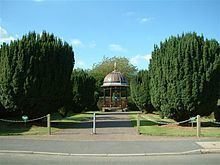Population 651 (2011 census) Civil parish Stoke Row Country England Area 6.08 km² District South Oxfordshire UK parliament constituency Henley | OS grid reference SU6884 Region South East Sovereign state United Kingdom Shire county Oxfordshire Dialling code 01491 | |
 | ||
Stoke Row is a village and civil parish in the Chiltern Hills, about 5 miles (8 km) west of Henley-on-Thames in South Oxfordshire and about 9 miles (14 km) north of Reading.
Contents
- Map of Stoke Row Henley on Thames UK
- History
- Parish church
- Ministers
- Maharajahs Well
- Amenities
- Notable residents
- References
Map of Stoke Row, Henley-on-Thames, UK
History
The toponym was first recorded in 1435. It means a "row of houses at Stoke" (Stoke being a common name for a secondary settlement or outlying farmstead).
Stoke Row was a hamlet divided between the ancient parishes, and later civil parishes, of Ipsden, Newnham Murren and Mongewell. It became a chapelry in 1849. From 1932 it was divided between Ipsden and Crowmarsh (into which Newnham Murren and Mongewell were merged) In 1952 Stoke Row was made a new civil parish.
Parish church
The Church of England parish church of Saint John the Evangelist was built in 1846. It was designed in 13th century style by the architect R.C. Hussey. St. John the Evangelist parish is now a member of The Langtree Team Ministry: a Church of England benefice that includes also the parishes of Checkendon, Ipsden, North Stoke, Whitchurch-on-Thames and Woodcote.
History
Stoke Row Independent Chapel was built in 1815 and there is a history of Dissenters meeting in the village. Dissenters had been meeting in the village since 1691, when they gathered in the drawing room of a local farmhouse. The Chapel was built in Flemish bond red brick on flint footings. The roof is slate hipped with overhanging eaves.
In the early years services were conducted by visiting ministers or licensed lay preachers, but in 1955 a wealthy local farmer, who had been a lifelong strong supporter, bequeathed a large piece of land opposite the chapel and on this houses were built. The resulting finance enabled a house to be built for the Minister and for chapel modernisation, including modern heating and the provision of a kitchen and toilets. A trust was also established and this still provides for the upkeep of the exterior of both buildings.
In 1978 Padre Bernard Railton Bax took over the ministry. His work was continued, after his death in 1990, by Rev John Harrington and his wife Nina. Mrs Harrington died in 1996 and Rev Harrington retired at the age of 87, after thirteen years of service.
The chapel has always been independent, but it has neighbourly links with the local Church of England parish church of St John the Evangelist. There was once a move to integrate with the Congregational Church, but the plan did not materialise. The chapel has an ecumenical attitude and residential Ministers in recent years have included a Baptist and several from a United Reformed Church background.
In 2016 the chapel has a choir and the meeting room, at the rear of the chapel, is used by many groups, one on a weekly basis. The current ministers are Revd David and Revd Sonia Jackson.
In June 2015 an outdoor service was held, attended by many villagers, to celebrate the 200th anniversary of the chapel. The congregation sat in a marquee in the chapel grounds and sang hymns with accompaniment from the Reading Central Salvation Army Band. Rev David and Rev Sonya Jackson gave readings and led prayers, as did Rev Kevin Davies, the minister for Henley deanery. The service was followed by a village picnic. A celebration cake was cut by 95-year-old Ken Jago, the oldest member of the congregation.
Ministers
Maharajah's Well
Edward Anderdon Reade, the local squire at Ipsden, had worked with the Maharajah of Benares in India in the mid nineteenth century. He had sunk a well in 1831 to aid the community in Azimgurgh. Reade left the area in 1860.
A couple of years later the Maharajah decided on an endowment in England. Recalling Mr Reade’s generosity in 1831 and also his stories of water deprivation in his home area of Ipsden the Maharajah commissioned the well at Stoke Row and it was sunk in 1863. The originally intended site for the well was Nuffield Common. All work was completed by the Wallingford firm of R. J. and H. Wilder.
Amenities
The village has two public houses. The Cherry Tree Inn dates from the 17th century and is a Brakspear tied house.
The Crooked Billet, a free house, was built in 1642 and is reputed to have once been the hideout of notorious highwayman Dick Turpin, who was alleged to have been romantically attached to the landlord's daughter, Bess. It was England's first gastropub and was the venue for Titanic star Kate Winslet's wedding reception. In June 1989, the British progressive rock band Marillion played their first performance with Steve Hogarth as frontman at the Crooked Billet, and a documentary DVD entitled From Stoke Row To Ipanema - A Year In The Life was subsequently produced.
In the 1851 census the head of the household at No 1 Stoke Row was George Hope, who built "The Hope" public house. This was later known as "The Farmer" and today is known as Farmer's Cottage, located on the corner of Main Street with Nottwood Lane.
The village has a Church of England primary school.
